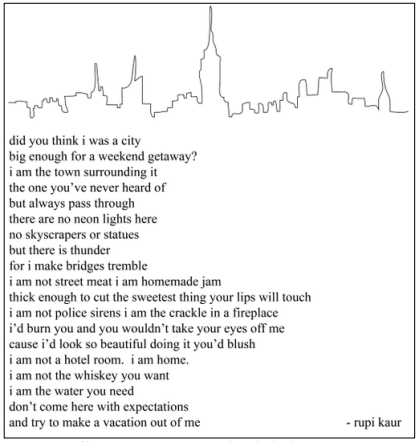Questões de Concurso Público Prefeitura de Pitangueiras - SP 2024 para Professor de Educação Básica II - Inglês
Foram encontradas 39 questões

(Disponible in: https://www.quora.com)
Having the image’s clues as references, apostrophe use meets a compatible description in:

(Disponible in: https://mortalreader.wordpress.com/2016/09/17/milk-and-honey-rupi-kaur)
When Rupi Kaur emigrated to Canada from Punjab, India, she was four. On Instagram, 2009, she started writing and performing poetry and became a worldwide success. Regarding text content, her poem’s core idea is:
Read the text to answer question.
The nature of “Language Input” for Language Acquisition
“INPUT” is a vital concept within language acquisition, especially within second language acquisition. Theoretical models in research on language acquisition typically require the explanation of how INPUT is treated by the learners and the impact on language acquisition.The presence of INPUT, however, does not guarantee acquisition. This is generally understood. Watching 20 hours of Korean drama does not necessarily lead to acquisition of Korean – if that worked, we would have loads of proficient Korean speakers around the world now. Notwithstanding that, we also understand that the absence of target language INPUT also implies no language acquisition will take place for the target language. This should also be easily understood. It cannot be the case that a person who has never listened to a word of Yiddish, to be able to speak Yiddish suddenly.
There are various theories on the psycholinguistic processes of how INPUT generates acquisition. Nevertheless, most scholars agree that INPUT needs to be converted to “INTAKE” before acquisition can take place. Using the analogy of the Korean drama earlier, we may also have heard of examples of learners who seemed to have acquire new understanding and able to use Korean at a slightly different level after watching numerous Korean dramas. Yet, the same experience does not always hold for all others. In that sense, for those who have improved or level up, INPUT has become INTAKE in their minds.
Technically speaking, INPUT is akin to data (in fact, some scholars define input as primary linguistic data) available in the environment that the learner has opportunity of access, and intake refers to the data that the learner actually takes in and process. Just as in data science where processed raw data then becomes useful information, LANGUAGE INPUT that is processed can then become information for acquisition – the psychological region where “new information is matched against prior knowledge” (Gass, 1997:5), enabling the learner to confirm/reject any previous hypothesis or form new hypothesis about the target language. Note that this can be implicit and is unknown to the learner.
The key question then is: What types of LANGUAGE INPUT can then have a higher opportunity of becoming INTAKE? This is one question of inquiry that research has yet to provide very conclusive answers, although there are many influencing factors. As such, the various types of LANGUAGE INPUT to be discussed contribute in different manners to acquisition. We should take note of these types to construct relevant languaging experiences for our learners.
(Disponible in: https://www.languageeducatorsassemble.com/types-of-language-input. Adapted.)
I. INPUT is basic linguistic information affordable in the ambience that the learner has the chance of accessing.
II. Several instances of INTAKE are instrumental in different ways to foster language acquisition.
III. INPUT may come through languaging in the daily lives of the learners, where the target language is used for all sort of purposes beyond education.